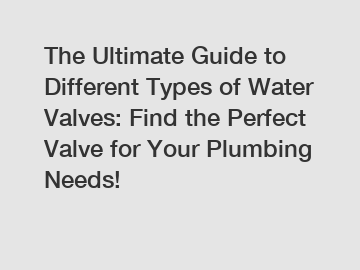The Ultimate Guide to Different Types of Water Valves: Find the Perfect Valve for Your Plumbing Needs!
The Ultimate Guide to Different Types of Water Valves: Find the Perfect Valve for Your Plumbing Needs!
Have you ever wondered about the different types of water valves available for your plumbing needs? When it comes to choosing the right valve for your plumbing system, it's crucial to understand the various options and their specific functionalities. In this ultimate guide, we will explore different types of water valves and help you find the perfect one for your specific requirements.
1. Ball Valves:

One of the most common types of water valves, ball valves, offer excellent shut-off capability. These valves consist of a lever handle and a hollow, perforated, or pivoting ball inside. When the lever handle is turned, the ball rotates, controlling the flow of water. Ball valves are durable, reliable, and can handle high-pressure applications. Moreover, they provide excellent sealing and are ideal for both residential and commercial plumbing systems.
2. Gate Valves:
Gate valves are designed to control the flow of water by raising or lowering a gate-like mechanism housed within the valve. These valves are commonly used in plumbing systems where a full flow or shut-off is required. Gate valves offer minimal flow restriction but are not recommended for applications that require frequent operation. They are prone to corrosion and mineral buildup, which can cause the gate to become stuck. However, gate valves are cost-effective and readily available, making them suitable for various plumbing needs.
3. Globe Valves:
Globe valves are primarily used to regulate fluid flow in applications that require fine control. These valves consist of a disc or plug that moves in a perpendicular direction to the flow, allowing for precise adjustments. Globe valves are suitable for both on/off and throttling applications. They offer good shut-off capability and can handle moderate pressure and temperature. However, compared to other valve types, globe valves tend to have higher pressure drops due to their design.
4. Check Valves:
Check valves, also known as non-return valves, are installed to allow flow in one direction and prevent backflow in the opposite direction. These valves are crucial in preventing water contamination and maintaining the integrity of plumbing systems. Check valves are commonly found in sump pumps, water treatment systems, and irrigation systems. They are available in various designs such as swing, spring-loaded, or tilting disc, each offering specific advantages depending on the application.
5. Pressure Reducing Valves (PRVs):
Pressure reducing valves are essential for controlling and maintaining optimal water pressure within a plumbing system. These valves automatically reduce high-pressure water to a more manageable level, preventing damage to appliances, fixtures, and pipes. PRVs are commonly used in areas where water pressure exceeds recommended limits. By regulating the pressure, PRVs ensure a consistent and safe water supply while extending the lifespan of plumbing components.
6. Butterfly Valves:
Butterfly valves are versatile and ideal for systems that require large volume control. These valves consist of a rotating disc that regulates flow using a quarter-turn motion. Butterfly valves are lightweight, compact, and offer low pressure drops. They are commonly used in HVAC systems, water treatment plants, and industrial applications. However, due to their design, they may not provide perfect shut-off capability and are not recommended for high-pressure applications.
7. Mixing Valves:
Mixing valves, also known as tempering valves, are responsible for blending hot and cold water to achieve a desired outlet temperature. These valves are commonly used in domestic hot water systems, showers, and sinks to prevent scalding and regulate water temperature. By accurately controlling the mixture, mixing valves ensure a comfortable and safe bathing experience. They are also energy-efficient, as they minimize the need for excessive hot water usage.
In conclusion, choosing the right water valve for your plumbing needs is crucial for maintaining a well-functioning and efficient system. Each type of valve discussed in this ultimate guide offers specific advantages and functionalities. Whether you require shut-off capability, pressure regulation, backflow prevention, or temperature control, understanding the different valve options will help you find the perfect fit for your specific requirements. So, next time you find yourself in need of a water valve, refer to this guide to make an informed decision and ensure the longevity of your plumbing system.
Contact us to discuss your requirements of angle valve manufacturer, self closing faucet supplier, valve brass fitting supplier. Our experienced sales team can help you identify the options that best suit your needs.
128
0
0


Comments
All Comments (0)